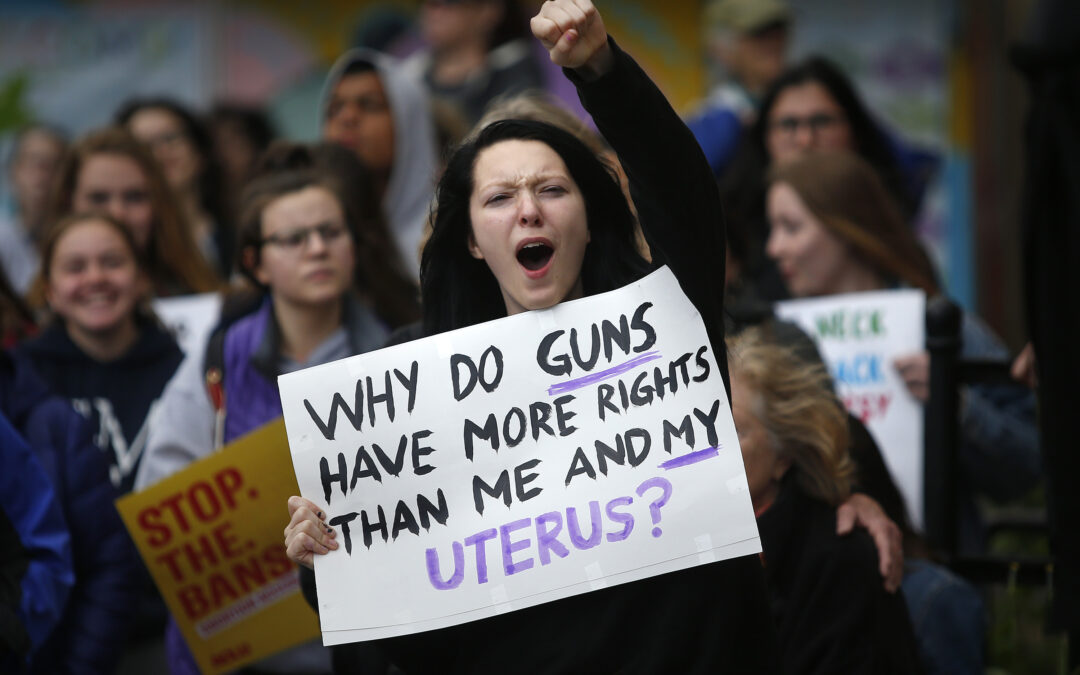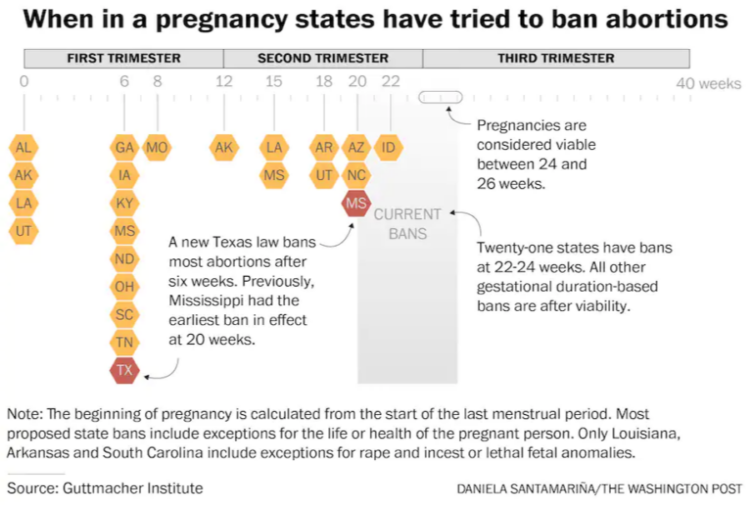The Supreme Court majority never mentioned Roe v. Wade in its 400-word order at midnight Wednesday greenlighting Texas’s most-restrictive-in-the-nation abortion law.
But it is difficult to imagine the court’s revitalized conservative majority is not ready to make substantial changes to the half-century of Supreme Court jurisprudence that controls a woman’s right to an abortion.
The first chance for justices to do that comes this fall, when the court considers a restrictive abortion law from Mississippi.
“Many already thought that the writing was on the wall for Roe, and this confirms it for me,” said Mary Ziegler, a Florida State University law professor and author of “Abortion and the Law in America: Roe v. Wade to the Present.
“The remaining questions,” she said, “are how and when it falls.”
The court’s order was based on legal procedure, and it went out of its way to say abortion providers and civil rights groups “raised serious questions regarding the constitutionality of the Texas law at issue.”
But the court’s willingness to let a ban on most abortions after about six weeks of pregnancy proceed while those questions are settled will affect, by the clinics’ estimate, more than 80 percent of women who would typically seek abortions in the nation’s second-largest state.
Permitting women to end their pregnancies only in the first few weeks, before many might even realize they are pregnant, is far from the rights Roe and the follow-up Planned Parenthood v. Casey guarantee, abortion rights groups say.
The court’s action “set back the hands of time, essentially allowing Texas to be a pre-Roe state,” said Alexis McGill Johnson, president and chief executive of the Planned Parenthood Federation of America.
If doubts about the future of Roe were one takeaway, the court’s brief order contained two other important lessons about the current Supreme Court.
One is that Chief Justice John G. Roberts Jr. is no longer able to impose the kind of middle-ground compromises he often favors when the court faces important, controversial issues.
None of his fellow conservatives joined his call to hold what he called a “not only unusual, but unprecedented,” law in abeyance until lower courts and the justices could examine it more closely.
That should be worrisome to liberals who see Roberts as their best hope to forge narrow and incremental compromises, and good news to some conservatives who feel Roberts can be an impediment.
As conservative legal commentator Ed Whelan wrote Thursday: “One bright note for those who fear that the Chief holds extraordinary sway over a couple of his conservative colleagues is that neither of them went south with him.”
The other takeaway is that the court’s conservative majority is comfortable establishing bold precedents in the emergency applications that come before the court, without the customary detailed briefing and argument that accompany cases on the regular docket.
Increasingly frustrated liberal justices, routinely outvoted in these emergency cases, sounded off.
Justice Elena Kagan wrote that her colleagues on the other side “barely bother” to explain why “a challenge to an obviously unconstitutional abortion regulation backed by a wholly unprecedented enforcement scheme is unlikely to prevail.”
She added: “The majority’s decision is emblematic of too much of this Court’s shadow-docket decisionmaking — which every day becomes more unreasoned, inconsistent, and impossible to defend.”
Kagan was criticizing the court’s one-paragraph order, which she wrote was reached “after less than 72 hours’ thought.”
The order was unsigned but was the product of the court’s most conservative justices — Clarence Thomas and Samuel A. Alito Jr. — and President Donald Trump’s nominees to the court: Neil M. Gorsuch, Brett M. Kavanaugh and Amy Coney Barrett.
The Texas law was specifically designed to keep federal courts from intervening before it could take effect. It replaced government officials who normally would enforce abortion restrictions with individual citizens. They can bring civil suits to impose damages, not on the woman who seeks an abortion past the six-week deadline but anyone who aids and abets her in any way.
The court’s order said challengers to the law did not show they were likely to succeed with their own novel plan to combat the law — stopping state court judges and clerks from accepting those civil lawsuits.
“Federal courts enjoy the power to enjoin individuals tasked with enforcing laws, not the laws themselves,” the opinion said, adding that “it is unclear whether the named defendants in this lawsuit can or will seek to enforce the Texas law against the applicants in a manner that might permit our intervention.”
It said the decision “is not based on any conclusion about the constitutionality of Texas’s law, and in no way limits other procedurally proper challenges to the Texas law, including in Texas state courts.”
Ilya Shapiro, vice president of the libertarian Cato Institute, said the majority was right. “The court was literally powerless to do anything about this law,” he said, “because the actual defendants in the lawsuit weren’t enforcing it and an injunction against them wouldn’t stop the law from going into effect.”
He said when an individual tries to sue under the law, “Roe/Casey will be raised as a defense and the lawsuit won’t get very far — and if it did, the Supreme Court would be faced with another emergency application in that different procedural posture.”
All of the dissenting justices wrote separately, an indication of the depths of their disagreement.
Unlike the others, Roberts did not characterize the Texas law as violating the court’s constitutional precedents. But he said it deserved more-detailed attention before implementation, especially since other states would probably copy it.
But only Kagan and Justice Stephen G. Breyer joined him.
They and Justice Sonia Sotomayor left no doubt they believed Texas was trying an end-around of the Constitution and the court’s precedents.
Breyer said it made no difference whether government officials or private citizens were doing the enforcement if the law “still threatens to invade a constitutional right . . . and threatens imminent harm.”
Kagan was more blunt. “Because of this Court’s ruling, Texas law prohibits abortions for the vast majority of women who seek them — in clear, and indeed undisputed, conflict with Roe and Casey.”
Sotomayor’s dissent was seething. “This is untenable,” she wrote. “It cannot be the case that a State can evade federal judicial scrutiny by outsourcing the enforcement of unconstitutional laws to its citizenry.”
Instead of her usual sign-off — “I respectfully dissent” — she wrote instead, “I dissent.”
The Mississippi case to be heard later this year concerns a law that forbids almost all abortions after 15 weeks. That is far below the standard set in Roe and Casey, which says states may not erect undue burdens on a woman’s choice to have an abortion before fetal viability — about 22 to 24 weeks.
The court said it will consider one issue in Dobbs v. Jackson Women’s Health Organization: “whether all pre-viability restrictions on elective abortions are unconstitutional.”
Wednesday night’s action indicates it will be a tall order for abortion rights activists to find five justices who will answer yes.
This article appeared in The Washington Post.

